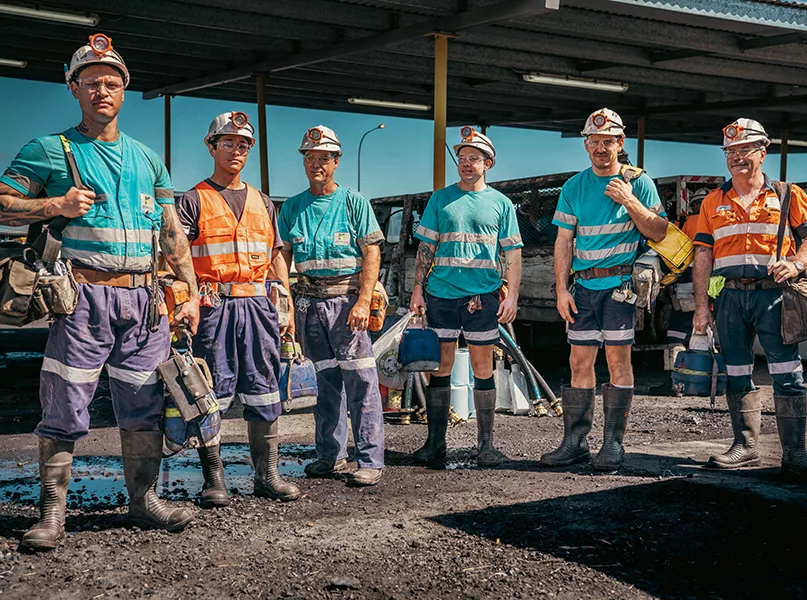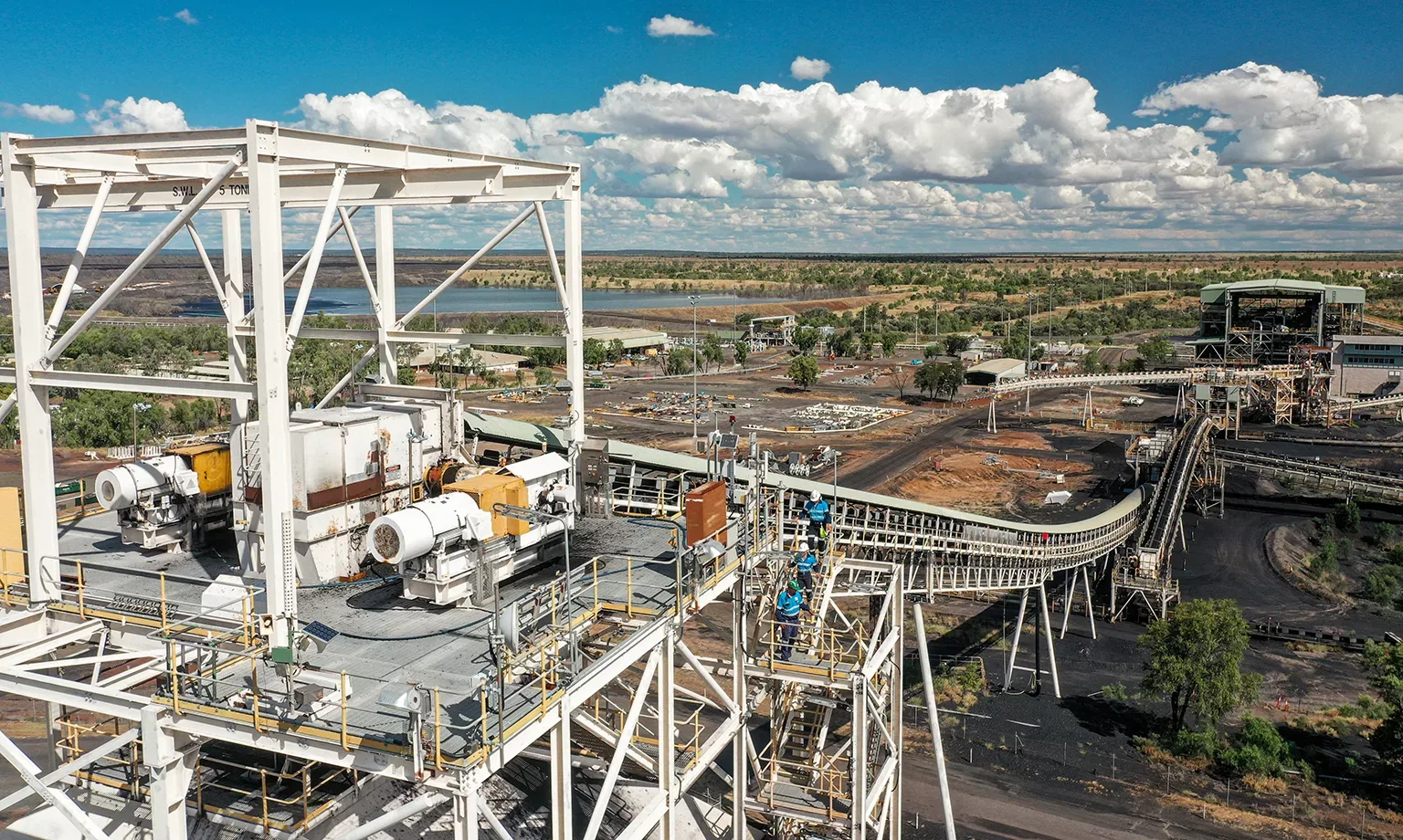SETTING THE STANDARD
Aside from the mine’s operational performance, Kestrel sets a new standard in longwall mining by creating a business that is community-focused, sustainable, and ultimately, a place that people want to be.
“Our greatest strength lies in our unique blend of a respectful culture, exceptional performance, and our long history of operating in the community,” Hansen acknowledges proudly.
This has been recognised with several prestigious accolades to date. Most recently, Kestrel was voted the 2022 Australian Mine of the Year at the Australian Mining Prospect Awards, and as winner of the 2019 Mine of the Year by Australian Mining Monthly. Both achievements serve as a testament to the dedication of the Kestrel team and its underlying culture of respect, trust, and positive communication throughout the business.
Through its comprehensive capabilities, Kestrel sets itself apart by living and breathing its core values of being respectful, agile, committed, and acting as one. Permeating throughout the entire company culture, these four core tenets are the adhesive that binds all of Kestrel’s individual moving parts into a collective force that is community-centric, and purpose driven.
Much like the coal entrenched in the ground on which it operates, by firmly embedding these values into its everyday actions and conversations, Kestrel builds the foundation from which the company prospers.
THE POWER OF ONE
Embodying its value of oneness, Kestrel is one company supporting the world’s largest industries and economies, as one community sharing the same set of values through one crew.
“We have fostered a one-team approach that resonates deeply within our organisation,” comments Hansen. “Our team understands that every job, no matter how small, contributes to the bigger picture of making our mine successful. Everyone digs deep to get it done and make Kestrel a great place to work.”
Hansen credits this approach as a major contributing factor to the company’s many “remarkable achievements”, including being Australia’s highest-producing underground metallurgical coal mine for the past four years.
“This accomplishment instils a sense of pride in our people and serves as a daily motivator for everyone to bring their best – not just at work, but also in their personal lives,” he continues.
Under the empowering mantra of ‘We Are One’, Kestrel cherishes each individual as a valued member of the team who brings the varied skills, experience and behaviours that are essential to the company’s success.
For Kestrel’s Strategic Sourcing Manager, Damian Cavill, it was this inclusive approach to teamwork that originally attracted him to the company.
“The reason I came to Kestrel is twofold – the people, and the culture,” he says. “The Kestrel team are some of the most experienced and technically proficient people I have met in the industry.”
Much of this team calls on the experience of Queensland’s esteemed mining legacy, which represents a colourful tapestry of strong characters and individuals with a potential that Kestrel seeks to unleash and encourage. This is done by honouring respect as a two-way street that guarantees appreciation for ideas, skills and solutions.
“There is a genuine respect for one another and when things get tough, we have each other’s backs, which makes everyone feel like a valued member of the team,” observes Hansen.
“Everyone digs deep to get the job done, have each other’s backs, and make Kestrel a great place to work”
Shane Hansen, CEO, Kestrel Coal Resources
A CHALLENGING CLIMATE
The internal sense of coherence and resilience fostered by the one-team approach combines with Kestrel’s agility to serve the company in good stead despite challenging industry conditions. Remaining united and adaptable helps Kestrel stay buoyant, as it continues to soar in the face of major recent headwinds.
“The challenges this industry faces are significant, with global economic conditions, changing energy policies and ongoing public scrutiny around carbon emissions,” Hansen observes. “However, these challenges also bring opportunities to innovate, adapt, and thrive.”
The mining of fossil fuels and the wider industry’s carbon footprint have become contentious issues within the fraught context of the ongoing climate crisis. However, Kestrel advocates a bright future for Australian coal mining, one in which the industry can evolve to operate more sustainably while holding the answers to the brave new world of the energy transition.
“With modernisation, the industry has responded swiftly to artificial intelligence (AI) and automation, which makes it an exciting place for people to start their careers and become part of urbanisation and decarbonisation,” he remarks.
On a path of constant innovation, Kestrel navigates the quandary that exists between the widespread negative environmental perception of mining, and the inescapable necessity of extraction to provide the resources needed to fuel our modern world. This is best defined by its stance as a company that seeks to provide resources responsibly, as evidenced by its continually maturing environmental, social and governance (ESG) strategy and comprehensive annual sustainability reports that transparently outline its progress.
Aside from its ongoing internal efforts in carbon reduction, the very nature of Kestrel’s flagship product contributes to driving wider, positive change on a global scale.
“The intrinsic connection of metallurgical coal with the broader process of decarbonisation makes for an exciting future,” hints Hansen optimistically. “The metallurgical, or steelmaking, coal industry in Australia is always facing new challenges, but we’re prepared for that.”
SPEARHEADING SUSTAINABLE STEEL
More than just a coal mine, Kestrel actively contributes to building the framework of our contemporary world by providing the core ingredient of one of its most important materials – steel. Coking coal is the lifeblood of steelmaking, which is an industry that is powering the transition to a renewable future.
“Metallurgical, or coking, coal is an essential ingredient in steel production, which continues to be indispensable in our modern society,” adds Hansen.
Aside from being a core element in the construction of wind turbines, solar panels, and electric vehicles (EVs), steel is used in a number of technologies that are instrumental to carbon reduction. Using the example of a wind turbine, approximately 250 tonnes of metallurgical coal are required to build a single model, since steel is needed to manufacture each individual component, from the generator and the blades to its very foundation.
Unsurprisingly, the ongoing energy transition has resulted in a booming demand for the resources necessary to fuel a future that uses renewable technologies and provides the robust infrastructure to house an ever-growing global population.
“Despite often being unappreciated, the resources sector has been a cornerstone of our economy and continues to play an integral role, particularly as we navigate the challenges and opportunities associated with global changes in the way that energy is consumed and produced,” Hansen confirms.
Consequently, the demand for steel – and by extension, metallurgical coal – continues steadily, running in parallel with the global need for urbanisation and infrastructure development. Fortunately for Kestrel, it is a demand that shows no sign of abating.
“For decades to come, steelmaking coal will be required to help facilitate the transition to a greener and more sustainable global economy,” he comments.
THINKING GLOBALLY, ACTING LOCALLY
Cognisant of the impact of steel on the global economy, Kestrel leverages a robust network of international markets where the demand for its metallurgical coal is high. Thanks to the product’s low impurity levels and niche coking properties, Kestrel coal is coveted by steel and coke makers across Asia, Europe and South America.
“Our Kestrel team has great relationships with our global customers and the growth potential in emerging markets is extremely exciting,” shares Hansen.
For Kestrel, India is a prime example of a new and developing market where the appetite for industrialisation has introduced a rapidly escalating need for steel. According to a report by the Economic Times, India produces approximately 126MT of crude steel per year and consumes 106MT. These statistics make the country the second-largest global producer of crude steel, second only to China. Consequently, India now represents Kestrel’s largest market, followed closely by North-East Asia.
“Kestrel is well-positioned to meet India’s increasing demand for steel,” he asserts.
The company’s agency on the global market reflects its internal philosophy, which acknowledges that Kestrel operates in a world that is shared and interconnected across people, environments, cultures and economies.
Kestrel may be global in its reach, but it is local in its everyday. Closer to home, this emphasis on locality translates to supporting the community and local, state, and regional economies wherever possible.

































